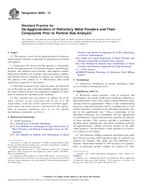Potřebujeme váš souhlas k využití jednotlivých dat, aby se vám mimo jiné mohly ukazovat informace týkající se vašich zájmů. Souhlas udělíte kliknutím na tlačítko „OK“.
ASTM B859-13
Standard Practice for De-Agglomeration of Refractory Metal Powders and Their Compounds Prior to Particle Size Analysis
Automaticky přeložený název:
Standardní praxe pro De-aglomerace žáruvzdorných kovových prášků a jejich sloučenin Před Analýza velikosti částic
NORMA vydána dne 1.10.2013
Informace o normě:
Označení normy: ASTM B859-13
Poznámka: NEPLATNÁ
Datum vydání normy: 1.10.2013
Kód zboží: NS-8453
Počet stran: 3
Přibližná hmotnost: 9 g (0.02 liber)
Země: Americká technická norma
Kategorie: Technické normy ASTM
Kategorie - podobné normy:
Anotace textu normy ASTM B859-13 :
Keywords:
de-agglomeration, laboratory-milled, laboratory milling, molybdenum, particle size analysis, powders, refractory metals, rhenium, rod-milled, rod milling, tantalum, tungsten, tungsten carbide, ICS Number Code 77.160 (Powder metallurgy)
Doplňující informace
| Significance and Use | ||||||||||||
|
4.1 Refractory metal powders, such as tungsten and molybdenum, are usually produced by hydrogen reduction at high temperatures. Thus, they usually contain numerous large, strongly-sintered agglomerates. Many of the manufacturing processes using these powders involve a milling step or some similar treatment or depend on the individual particulate size, not on the agglomerate size.4 Thus, a knowledge of the individual particulate size distribution, not the agglomerate size distribution, is usually desired from a particle size analysis of these powders. This practice provides a procedure for breaking down agglomerates into their constituent particles (de-agglomeration), without excessive fracture of the individual particles. The procedure is often referred to as laboratory milling or 4.2 The laboratory milling conditions specified in this guide have been in use since 1965, initially as part of a particle size analysis test method. This guide was first published as a separate, stand-alone standard in 1995 because of its applicability in preparing powder samples for analysis by other methods as well (for example, Test Methods B761 and B822). Information on the development and establishment of the milling conditions here specified can be found in the footnoted reference.4.3 The milling procedure described in this practice does not necessarily break down only agglomerates without fracturing individual particles; some particle fracture may occur in certain powders. However, use of this practice 4.4 This practice shall be used for the de-agglomeration of the refractory metal powders and compounds listed in 4.5 This practice may be used in preparing samples for Test Methods B330, B761, B822, and other particle size analysis methods, prior to the dispersion procedure of Guide B821, if used. |
||||||||||||
| 1. Scope | ||||||||||||
|
1.1 This practice covers the de-agglomeration of refractory metal powders and their compounds in preparation for particle size analysis. 1.2 Experience has shown that this practice is satisfactory for the de-agglomeration of elemental tungsten, molybdenum, rhenium, and tantalum metal powders, and tungsten carbide. Other metal powders (for example, elemental metals, carbides, and nitrides) may be prepared for particle size analysis using this practice with caution as to effectiveness until actual satisfactory experience is developed. 1.3 With the exception of the values for mass, for which the use of the gram (g) unit is the long-standing industry practice, the values stated in SI are to be regarded as standard. No other units of measure are included in this standard. 1.4 This standard does not
purport to address all of the safety concerns, if any, associated
with its use. It is the responsibility of the user of this standard
to establish appropriate safety and health practices and determine
the applicability of regulatory limitations prior to use.
Standard Guide for Liquid Dispersion of
Metal Powders and Related Compounds for Particle Size Analysis Standard Test Method for Particle Size
Distribution of Metal Powders and Related Compounds by Light
Scattering Detailed Drawings of Alternative Steel
Milling Bottles Available from ASTM International Headquarters.
Order Adjunct No. . Standard Terminology of Powder
Metallurgy Standard Test Method for Particle Size
Distribution of Metal Powders and Related Compounds by X-Ray
Monitoring of Gravity Sedimentation Standard Test Methods for Estimating
Average Particle Size of Metal Powders and Related Compounds Using
Air Permeability |
Podobné normy:
Historická
1.6.2014
Historická
1.10.2012
Historická
1.11.2012
Historická
1.10.2010
Historická
1.4.2008
Historická
1.9.2010
Odebírejte informace o nově vydaných normách ZDARMA:
Chcete pravidelně odebírat informace o nově vycházejících normách z celého světa a to zcela zdarma?
Přihlašte se k odběru. Vše je velice jednoduché a absolutně ZDARMA.
Na výběr máte vydavatele z celého světa.



 ASTM B312-14
ASTM B312-14 ASTM B329-06(2012)..
ASTM B329-06(2012).. ASTM B330-12
ASTM B330-12 ASTM B331-10
ASTM B331-10 ASTM B362-91(2008)..
ASTM B362-91(2008).. ASTM B406-96(2010)..
ASTM B406-96(2010)..
 Cookies
Cookies
